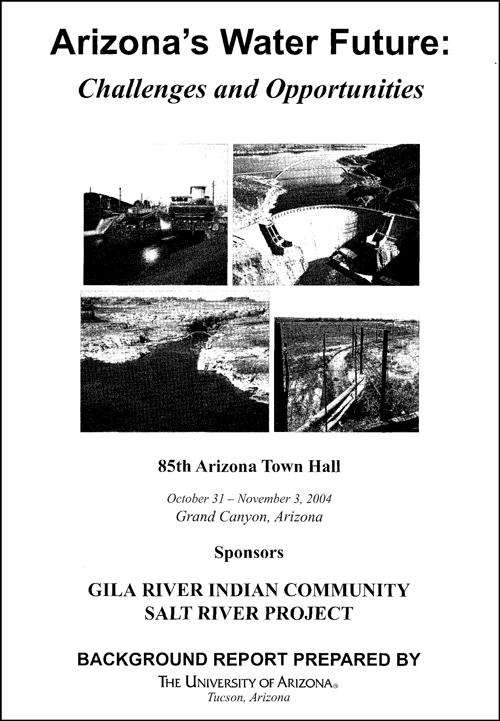
It has been almost two years since I joined the University of Arizona’s Water Resources Research Center and began writing this column addressing water issues of importance to Arizona. This time I am using this column for a different purpose. I will describe some WRRC programs and activities as a way to encourage you to consider what value WRRC has to you now and what we could do to serve you even better.
In operation since 1957, the center has congressional standing as one of the National Water Research Institutes. We administer the federal 104b grant program in Arizona, using U.S. Geological Survey funds. This is a core activity for interacting with researchers from the other two Arizona state universities. WRRC has had a long-term commitment to statewide outreach and education on state water issues. More recently, we renewed our emphasis on providing expertise on state and regional water management and policy.
The WRRC has been working closely with three other UA campus water centers to develop and implement the Water Sustainability Program, funded by the Arizona Board of Regents using voter-approved education sales revenues. This effort, which is part of the UA Technology Research and Initiative Fund (TRIF) program, has enabled the WRRC to expand its water resources research, education and outreach activities.
People generally know WRRC from its programs and activities. We publish this newsletter, the bi-monthly Arizona Water Resource. Editor Joe Gelt writes much of the content. Since joining the WRRC, I have been writing this column. The free publication reaches about 2,400 individuals and is posted on our web site. In addition, we publish papers as part of an Arroyo series and occasional issues papers. We have produced two versions of the Arizona Water Map poster and are in the process of finalizing Version 2 of our popular landscape CD.
If you have not recently done so, I invite you to visit our website. We have added a “Papers and Presentations” tab for recently posted papers including “How Water Management in Tucson, Arizona Has Affected the Desert’s Landscape,” a paper I wrote based on a presentation I made last spring in Santiago, Chile, and “Managing to Avoid Crisis: A Look at Water Management Efforts in Rural Arizona,” a paper Jackie Moxley and I wrote based on our May 2003 conference. The site is also home to selected Power Point presentations given by WRRC personnel. Also it includes information on our upcoming conference and 104b and TRIF grant programs. We also provide web links to many other water resource sites.
Another WRRC component, Project WET (Water Education for Teachers) is an extremely successful program that trains teachers to integrate water resources into the K-12 curriculum. Kerry Schwartz directs the program director, with the able assistance of Dana Flowers who offices with Maricopa County Cooperative Extension. The WRRC Project WET organizes the very popular annual Water Festival Program.
Housed at the WRRC, the Water Conservation Alliance of Southern Arizona (Water CASA), directed by Val Little, has its own board of directors representing its membership. It has an extensive involvement in municipal water conservation and greywater use and is expanding its research efforts.
The WRRC’s annual statewide water conference is an important center activity. The 2003 conference on regional approaches to water management attracted about 200 people from 40 Arizona communities. Planning is well underway for the April 28, 2004 conference on the future of agricultural water use in Arizona. (See Announcements, page 10, for conference info.) We are already looking forward to the 2005 conference on water and the environment.
In addition, the WRRC provides both on-campus and off-campus speakers the opportunity to make presentations through our “brown-bag” lunch-time seminars, and we often schedule presentations on water issues of interest for international and other visitors.
The WRRC is increasing its water policy work, with the objective of being viewed as a think tank for state and regional water policy. With papers, presentations, lectures and research, WRRC personnel have increased their water policy work. WRRC faculty and staff will work cooperatively with others on campus and with off-campus entities and agencies, including other state universities.
Research underway includes work by Terry Sprouse on border water issues and Kathy Jacobs’ work on the connection between climate and water management, particularly in the context of drought planning and the use of scientific information in decision making. Jackie Moxley and I are examining questions related to public versus private ownership of water companies in Arizona as well as looking at changes in agricultural activity over time.
WRRC leadership will soon be changing. College of Agriculture and Life Sciences Dean Eugene Sander recently announced that I will be the director when Peter Wierenga retires as director on June 30, 2004. As we look to the future, we are gathering feedback and input from interested groups and individuals regarding our activities. We held four small-group stakeholder meetings in December, two in Phoenix and two in Tucson, with both internal to the university and external stakeholders included.
I also want to invite your comments and suggestions. In particular, I ask you to consider the following questions: What WRRC activities are of value to you or assist you in your efforts? What other efforts would you like to see us undertake? Are there ways we can be more effective as an independent voice on water resources management and policy, both statewide and regionally (intrastate and interstate)? How can we work together more effectively?
Please email responses by Feb. 6 to smegdal@ag.arizona.edu or mail them to me at the WRRC, University of Arizona, 350 N. Campbell Ave., Tucson, AZ 85719. I look forward to receiving them.

